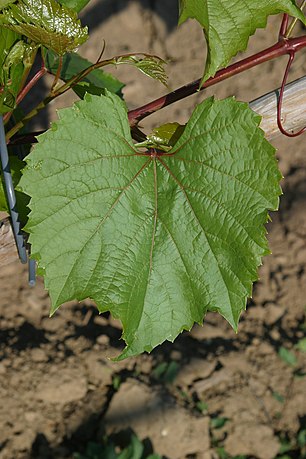101-14 Millardet et de Grasset
| Millardet et de Grasset 101-14 | |
|---|---|
| Synonyms | 101-14 MG - for more see section Synonyms |

|
|
| use | |
| origin | France |
| breeder | Alexis Millardet and Charles de Grasset. |
| Breeding year | 1882 |
| Launch | 1893 |
| VIVC no. | 7745 |
| ancestry | |
|
Hybrid of |
|
| List of grape varieties | |
The grape variety document 101-14 Millardet et de Grasset belongs to the group of Vitis rupestris × Vitis riparia - hybrids. It is a special underlay for salty soils. It is sensitive to drought and not very tolerant of lime.
ancestry
Cross of Vitis rupestris × Vitis riparia by Pierre-Marie Alexis Millardet and Charles de Grasset, France, 1882.
This document comes from the crossing series "101", which was carried out by Alexis Millardet at the University of Bordeaux in 1882. As the parent of the crosses, he used Vitis Rupestris as the mother and Vitis Riparia as the father variety. From this he received 21 seedlings, the offspring of which were propagated until 1892 as a mixed set on the vineyards made available by Charles de Grasset. From this, Prosper Gervais then selected "101-14" in 1893, which turned out to be the best base for this series of crosses.
Ampelographic features
- Shoot tip: closed - half-open, light green upper side, lower side woolly hairs
- Young leaves: somewhat copper-colored, smooth upper surface
- Full-grown leaf: medium-sized to large, heart-shaped, smooth, dull, yellowish green, slightly wavy with indicated tri-lobes, leaf teeth ogive, medium-sized, leaf margin glabrous above and below, main veins hairy on the underside of the leaf, petiole: wide open, U-shaped, petiole red, ribbed, slightly hairy
- Shoots: smooth, hairless, grooved with red-violet coloring, relatively short internodes
- Flower: female pseudo-hermaphrodite
- Grape: small, with black, rounded berries
Properties - use
It has a weak to medium-strong growth. It prematurely ripens the grapes and is tolerant of waterlogging in spring. It is very sensitive to drought and not well tolerated by lime and has a very low level of resistance to the root aphid.
It is well suited as a rootstock for salty soils, also for clayey fertile soils in early, not too dry locations.
Synonyms
Designations for the variety contain the number "101-14" and often an abbreviation "MG", "MGT" or the crossbreeding of Riparia and Rupestris in different spellings.
literature
- Karl Bauer, Ferdinand Regner , Barbara Schildberger: Viticulture (= AV book. ). 9th, updated edition. Cadmos, Vienna 2013, ISBN 978-3-7040-2284-4 .
- DP Pongrácz: Rootstock for Grape-vines. David Philip Publisher, Cape Town et al. 1983, ISBN 0-908396-67-8 , pp. 83-84.
- Joachim Schmid, Frank Manty, Bettina Lindner: Geisenheimer grape varieties and clones (= Geisenheimer reports. 67). Geisenheim Research Institute - Department of Vine Breeding and Refinement, Geisenheim 2009, ISBN 978-3-934742-56-7 .
Individual evidence
- ↑ Joachim Schmid, Frank Manty, Bettina Lindner: Geisenheimer grape varieties and clones. 2009.
- ^ Karl Bauer, Ferdinand Regner, Barbara Schildberger: Viticulture. 9th, updated edition. 2013, p. 120.
- ↑ Joachim Schmid, Frank Manty, Bettina Lindner: Geisenheimer grape varieties and clones. 2009, pp. 142-143.
Web links
- 101-14 Millardet et de Grasset in the database Vitis International Variety Catalog of the Institute for Grapevine Breeding Geilweilerhof (English)
- Joachim Schmid, Frank Manty, Bettina Lindner: Geisenheimer grape varieties and clones (= Geisenheimer reports. 67). Geisenheim Research Institute - Department of Vine Breeding and Refinement, Geisenheim 2009, ISBN 978-3-934742-56-7 , pp. 142-143 , (PDF; 143 kB).




